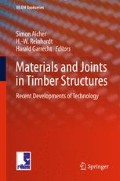Abstract
In consideration of sustainable buildings, closing life cycle loops becomes more and more important. Up to now reuse and recycling is taken rarely into account in building processes. With rising consumption of wood for energetic use recycling of material becomes more important.
Up to now there are various studies in EU market ([1], [2], [3]), which quantify the usage of wood in market shares. Explicit calculations on recycling of wooden material in the building sector have not yet been done. In general the demand for reclaimed wood products in the building sector will rise due to the fact that the preferred option has to be the reuse and the recycling of reclaimed wood. The thermal use of wood is the last option in the cascade of use. On this option the refinement of reclaimed wood for innovative products as well as the broadening and enhancement of the cascades of reuse and recycling is strongly needed for the timber construction industry. Long-term and resource efficient use of wood from premium quality (like laminated wood, plywood, timber frame construction) is necessary to ensure sustainable construction with wood. In the process of planning new wooden construction the dismantling and reuse / recycling of the products has to be considered too.
In this paper outcomes of the woodwisdom-net research project ECO2– wood in carbon efficient construction – as well as calculations on wood consumption of wide-span timber structures and investigated case studies on a very detailed level are brought together to show the state of art and theories to improve resource efficient usage of wood. Aim is a realistic estimation of theoretical scenarios for end of life and their influence on planning processes as well as the influence on life cycle assessment according to EN 15978. In another approach the total demolition of an old wooden house in the Alps was evaluated. It is a typical example for a long-used construction with numerous repair intervals, changes, and additions. This leads to a wide variety of fractions and often to a contamination of wood from preservatives. The fractions of the demolished house mainly consist of small bits and pieces dedicated to different recycling options than wide span structures. The different waste wood fractions in strength, scale, and size will tolerate certain processing options with an emerging range of recycling products.
A better management of its renewable resources supports the material supply of the wood sector to ensure a long-term availability of solid wood products at reasonable prices. This will allow preservation and also gain market shares now and in the future.
Access this chapter
Tax calculation will be finalised at checkout
Purchases are for personal use only
Preview
Unable to display preview. Download preview PDF.
References
Lang, A.: Charakterisierung des Altholzaufkommens in Deutschland. Rechtliche Rahmenbedingungen – Mengenpotenzial – Materialkennwerte. Mitteilungen der Bundesforschungsanstalt für Forst- und Holzwirtschaft, Kommissionsverlag Buchhandlung Max Wiedebusch Hamburg, vol. 215 (2004)
Weimar, H.: Empirische Erhebungen im Rohstoffmarkt am Beispiel der neuen Sektoren Altholz und Großfeuerungsanlagen. Sozialwissenschaftliche Schriften zur forst- und Holzwirtschaft, vol. 9. Internationaler Verlag der Wissenschaften Frankfurt am Main (2009)
Mantau, U.: Rohstoffknappheit und Holzmarkt. In: Waldeigentum: Dimensionen und Perspektiven. Springer, Heidelberg (2010)
Holzzentralblatt, Leinfelden-Echterdingen (November 2012)
Green Paper. On Forest Protection and Information in the EU: Preparing forests for climate change SEC, 163 final (2010)
Mantau, U., et al.: EUwood - Real potential for changes in growth and use of EU forests. Final report. Hamburg/Germany, 160 p. (June 2010), http://ec.europa.eu/energy/renewables/studies/doc/bioenergy/euwood_final_report.pdf
Directive 2008/98/EC of the European Parliament and of the Council of 19 November 2008 on waste and repealing certain Directives. Official Journal L 312, 0003–0030 (2008), http://eurlex.europa.eu/LexUriServ/LexUriServ.do?uri=OJ:L:2008:312:0003:01:EN:HTML (July 16, 2012)
Verordnung über Anforderungen an die Verwertung und Beseitigung von Altholz Altholzverordnung – AltholzV (February 24, 2012)
Ordinance on the Management of Waste Wood, Bundesministerium für Umwelt (October 25, 2012), http://www.bmu.de/files/pdfs/allgemein/application/pdf/wastewood_ordinance.pdf
Hafner, A., et al.: Rohstoffverwertung in Nutzungskaskaden. Holzbau – die neue Quadriga, Wolnzach 3, 41–45 (2012)
ECO2-book, www.eco2wood.com (forthcoming, Summer 2013)
Hafner, A., et al.: Höllentalangerhütte – case study for end of life reuse and recycling methodologies. In: Proceedings of Sustainable Building Conference sb 2013 Munich, Munich, pp. 1457–1466 (2013)
Natterer, J., et al.: Holzbau Atlas Zwei, 1st edn. Birkhäuser (2001) ISBN 978-3764362300
Author information
Authors and Affiliations
Corresponding author
Editor information
Editors and Affiliations
Rights and permissions
Copyright information
© 2014 RILEM
About this paper
Cite this paper
Hafner, A., Ott, S., Winter, S. (2014). Recycling and End-of-Life Scenarios for Timber Structures. In: Aicher, S., Reinhardt, HW., Garrecht, H. (eds) Materials and Joints in Timber Structures. RILEM Bookseries, vol 9. Springer, Dordrecht. https://doi.org/10.1007/978-94-007-7811-5_8
Download citation
DOI: https://doi.org/10.1007/978-94-007-7811-5_8
Publisher Name: Springer, Dordrecht
Print ISBN: 978-94-007-7810-8
Online ISBN: 978-94-007-7811-5
eBook Packages: EngineeringEngineering (R0)

